Ants
Ants
There are more than 10,000 known species of ants living throughout the world. Ants can be identified by the constriction between the abdomen and thorax, which looks like a narrow waist. Their bodies are covered with a hard armour called the exoskeleton. Most ants are either red or black in colour, and their length can be anywhere from 1/3″ to 1/2″. Like other insects, they have six legs, each with three joints. Ants have large heads with compound eyes, elbowed antennae, and powerful jaws.
There are three types of adult ants living in the colony: the queen, female ants, and male ants. Queen ants are the largest ants in the colony. They have wings and their purpose is to lay eggs. The queens can live up to 30 years. Depending on the ant species and the size of the nest community, there may be one or more queens in the colony.
Female ants are smaller than the queen, wingless and sterile. Females result from fertilised eggs and can live up to three years. Known as workers or soldiers, female ants care for the eggs, tend to the larva, build and repair the nest, forage for food, and protect the colony.
Male ants develop from unfertilized eggs. Also called drones, male ants have wings and are fertile to mate with the queen. Male ants are much smaller than females and have longer antennae. The males only emerge from the colony for one day in order to mate. They usually die 10-14 days after mating.
The ant life cycle has four stages of development: egg, larva, pupa and adult. The queen lays the eggs, which will hatch into larvae in a couple of days. The helpless larvae are fed and groomed by the worker ants until they pass through the pupal stage. In a little more than a week, an adult ant will emerge and the metamorphosis is comAnts.
Carpenter Ants
Carpenter ants are an excellent indicator of moisture problems in a building, or other conditions conducive to their infestation, such as rotting wood, that need attention. Carpenter ants do not eat wood but will excavate it for their nest. At times these ants will move into the attic of a home and create a satellite nest. These ants forage at night and may be seen around lights within a home. These are very large ants and the colour will vary from Black to Brown to Black and Brown.


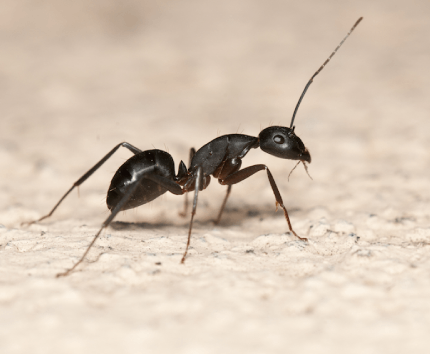


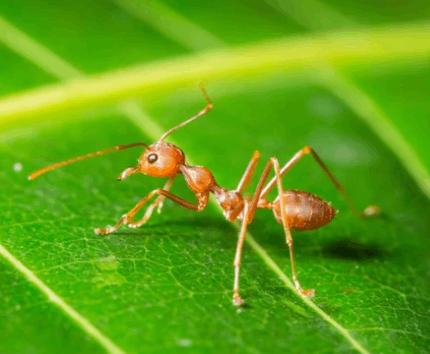
Fire Ants
Fire ants can prey on small, ground-dwelling vertebrates, including mammals, such as mice, ground-nesting birds, and ground-dwelling reptiles and amphibians. In most cases it is the hatching eggs or helpless, immobile young that are attacked. Several studies have shown the abundance of ground-dwelling animals declines significantly when there are high densities of imported fire ants. Fire ants also opportunistically feed on carcasses of larger animals and will attack sick or injured animals that have become immobile. Fire ants defensive mechanism is a stinger with a highly potent venom.
Acrobat Ants
Acrobat Ants got their name because of the way they sometimes hold their abdomens up in the air when running as if performing an acrobatic stunt. Acrobat Ants may nest outdoors in decaying logs, stumps, and hollow tree cavities, or indoors within voids (including abandoned carpenter ant nest and termite galleries) and insulation. Acrobat ants feed on a variety of foods including other ants, sweet foods (such as honeydew), and proteins.


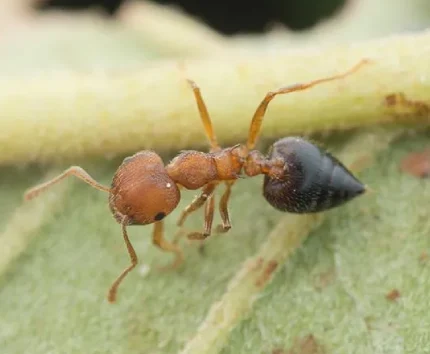


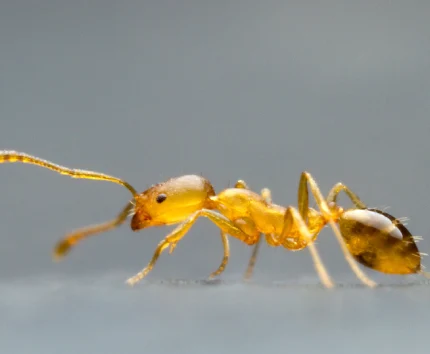
Pharaoh Ant
This is a very small ant that will be seen trailing slowly along a very distinct line when foraging for food. This ant is a genuine pest in hospitals, where it is known to infest sutures of surgery patients and have been found in IV bottles. Pharaoh ants feed on a variety of foods including honey, jelly, peanut butter, shortening, corn syrup, grease, sweet, sugary foods, and dead insects. They are uniform in color and may be found nesting in homes. This ant will separate a colony readily when disturbed. This process is called budding, which will result in the spreading of an infestation, rather than controlling it.
Ghost Ants
This is also a very small ant that will follow a distinct trail. Rather than walk slowly, this ant tends to walk faster than Pharaoh ants. These ants feed almost exclusively on sweets and will readily infest homes. These ants are hard to see, since their abdomen is white to clear which gives the impression that it is even smaller than it really is. These ants are a common pest around the world.


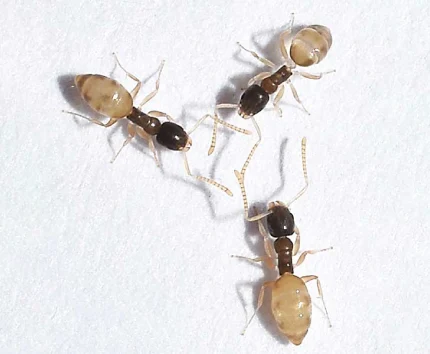


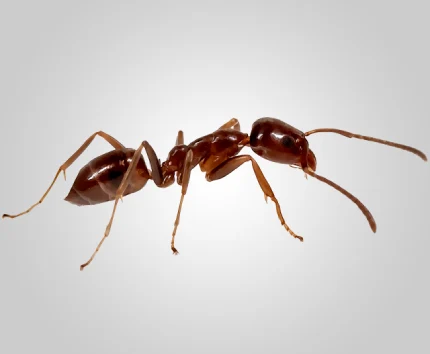
Argentine Ants
Argentine ant workers move steadily in defined continuous trails and tend to walk over objects placed on trails. Their trails can often be found along smooth surfaces, and in the urban environment they are commonly found by pulling back the grass at the edge of the footpath. Trails can often be found ascending flowering trees and shrubs. Nests can be found under wood, stones, piles of leaves and in potted plants. This ant is not aggressive to other colonies of Argentine ants and will combine colonies readily. This ant will eliminate other types of ants in the area by attacking in sheer numbers.
Big-Headed Ants
About 1% of the colony is made up of the larger ant. This ant is not used for protection, but instead it is utilized to break up large pieces of food into manageable sizes. Infestations of big-headed ants are characterized by lines of inter-connected holes and small mounds of excavated soil. Excavations can be so extensive that brick paving is destabilized and the roots of plants and the lawn can become so aerated that the plants subsequently die by drying out. Often the small worker ants are hard to see, but foods put out for pets can become covered in ants.


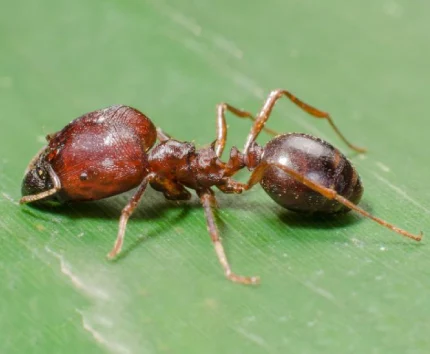


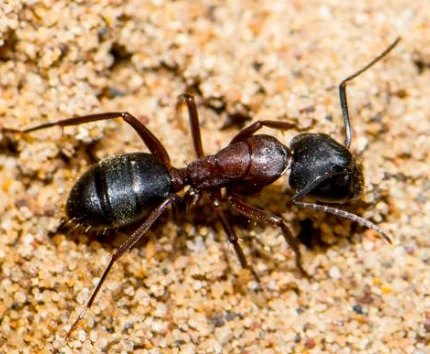
Velvety Tree Ant
This is not an ant at all, rather it is a wasp with a sever sting. After bees or wasps have formed cocoons, adult female velvet ants enter the host nest by digging through the soil or breaking through nest walls. Each chews a hole through the cocoon wall and deposits a single egg on the host larva. Usually the hole is sealed and the next cocoon is attacked. The egg hatches and the velvet ant larva feeds on the host. This host is ultimately killed.
Caribbean Crazy Ants
This ant is normally identified just by its sheer numbers. When a colony is on the move or foragers are locating a food source, these ants will move in mass. Trails of these ants can be seen on the side of a home from 50 yards away. The colonies are huge and will eliminate food sources for other types of ants. These ants do not bite or sting, but are considered a nuisance because of their numbers. These ants live outside, but will readily enter a structure in search of a food source.





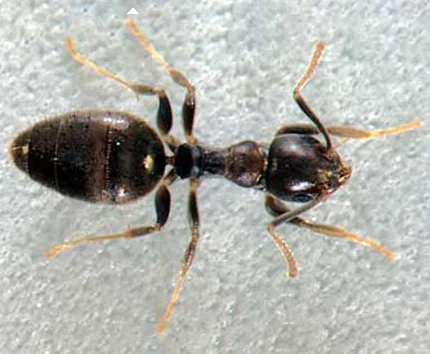
White footed Ants
White-footed ants prefer sweet foods and dead insects (such as termites and cockroaches), but will also feast on tree and flower nectars. The heaviest concentration of foraging white-footed ants occurs at night during the summer. An interesting fact about white-footed ants is that the workers do not regurgitate food to share with other ants in the colony, as do most ant species. Instead, the workers lay unfertilized eggs which they feed to other ants in the colony that are not active foragers. What this means for pest control is that baiting is not effective with white-footed ants. Since white-footed ants do not share food, toxic baits affect only those ants that directly ingest it rather than being shared and spread throughout the colony.
Crazy Ants
This ant is easily identified by its long elbowed antenna. The other distinguishing feature is that it forages for food in a seemingly random fashion. These ants will be seen along sidewalks running in many different directions hence the name “Crazy Ant”. These ants will invade a structure when a food source is found.


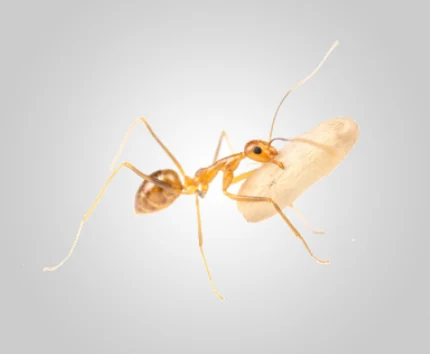



Pyramid Ants
They nest in soil that is preferably sandy. The nest has a single entrance surrounded by a crater-shaped mound of soil and a there is a single queen per nest. They feed on a variety of foods including other insects, but have a preference for sweets. Pyramid ants usually nest in bright, sunny, open-spaces in lawns. Oftentimes, pyramid ant nests will be in close proximity to fire ant nests because pyramid ants are predators of the winged male and female fire ants.
Ant control via pest control services involves identifying the ant species and using targeted treatments, such as baits and insecticides, to eliminate colonies. Professionals may also seal entry points and recommend sanitation practices to prevent future infestations.
Our Clients













Truly is present in more than 37 cities across the country, having more than 400 employees. TPS is currently serving 4000+ commercial and 10000+ residential clients, with an increasing list of clients on a daily basis.
- 915, Hemkunt Tower, 98 Nehru Place, New Delhi -110019.
© Truly Nolen 2023 . All Right Reserved. Designed By Verve Media.
